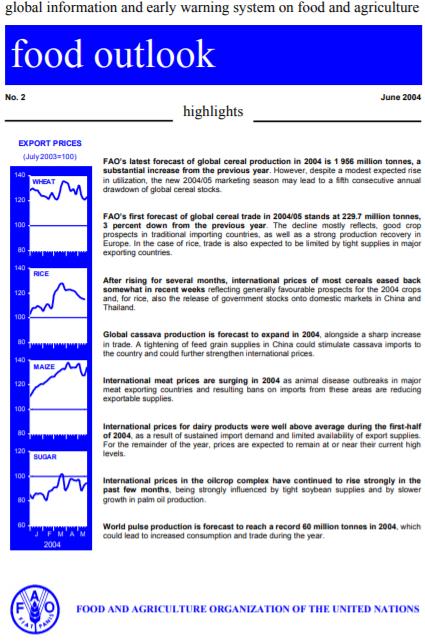
Food Outlook - June 2004
04/06/2004
FAO’s latest forecast of global cereal production in 2004 is 1 956 million tonnes, a substantial increase from the previous year. However, despite a modest expected rise in utilization, the new 2004/05 marketing season may lead to a fifth consecutive annual drawdown of global cereal stocks. FAO’s first forecast of global cereal trade in 2004/05 stands at 229.7 million tonnes, 3 percent down from the previous year. The decline mostly reflects, good crop prospects in traditional importing countries, as well as a strong production recovery in Europe. In the case of rice, trade is also expected to be limited by tight supplies in major exporting countries. After rising for several months, international prices of most cereals eased back somewhat in recent weeks reflecting generally favourable prospects for the 2004 crops and, for rice, also the release of government stocks onto domestic markets in China and Thailand. Global cassava production is forecast to expand in 2004, alongside a sharp increase in trade. A tightening of feed grain supplies in China could stimulate cassava imports to the country and could further strengthen international prices. International meat prices are surging in 2004 as animal disease outbreaks in major meat exporting countries and resulting bans on imports from these areas are reducing exportable supplies. International prices for dairy products were well above average during the first-half of 2004, as a result of sustained import demand and limited availability of export supplies. For the remainder of the year, prices are expected to remain at or near their current high levels. International prices in the oilcrop complex have continued to rise strongly in the past few months, being strongly influenced by tight soybean supplies and by slower growth in palm oil production. World pulse production is forecast to reach a record 60 million tonnes in 2004, which could lead to increased consumption and trade during the year.
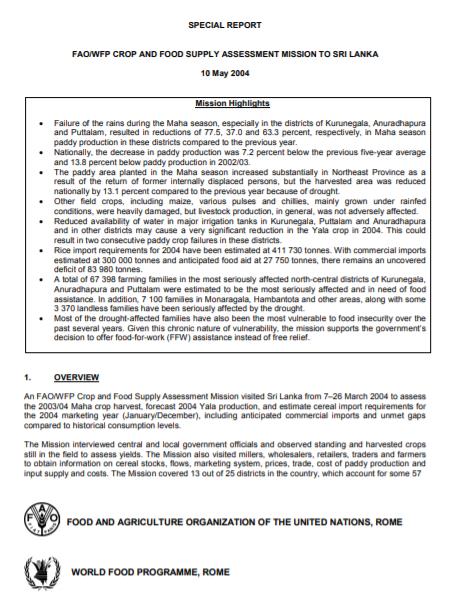
Special Report - FAO/WFP Crop and Food Supply Assessment Mission to Sri Lanka
10/05/2004
An FAO/WFP Crop and Food Supply Assessment Mission visited Sri Lanka from 7–26 March 2004 to assess the 2003/04 Maha crop harvest, forecast 2004 Yala production, and estimate cereal import requirements for the 2004 marketing year January/December), including anticipated commercial imports and unmet gaps compared to historical consumption levels.
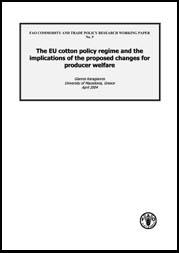
The EU Cotton Policy Regime and the Implications of the Proposed Changes for Producer Welfare
14/04/2004
A new European Union (EU) policy regime has been announced for cotton for introduction in 2005. The orientation is towards a scheme which includes a mix of coupled and decoupled measures, i.e., a mix of non trade-distorting (green box) and less trade-distorting (blue box) forms of farm support. These measures include a fully decoupled single farm payment (income aid) and an area payment (production aid). The aim of the present study is to evaluate the proposed EU cotton policy regime in welfare terms. A partial equilibrium model was used to simulate results of the new policy over the period 2000 to 2003, with various assumptions of supply and demand elasticities for Spain and Greece. Two main conclusions are drawn from the simulation results: first, if the proposed policy regime had been in effect during this period, cotton producers would, on average, have been better-off than under the existing policy regime. The magnitude of change, i.e., the additional farm income, depends on the value of the supply elasticity. Second, the proposed policy regime would have resulted in savings to taxpayers in supporting cotton farmers.
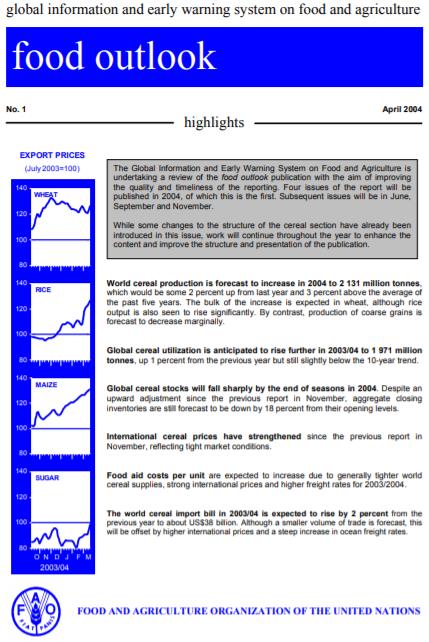
Food Outlook - April 2004
05/04/2004
World cereal production is forecast to increase in 2004 to 2 131 million tonnes, which would be some 2 percent up from last year and 3 percent above the average of the past five years. The bulk of the increase is expected in wheat, although rice output is also seen to rise significantly. By contrast, production of coarse grains is forecast to decrease marginally. Global cereal utilization is anticipated to rise further in 2003/04 to 1 971 million tonnes, up 1 percent from the previous year but still slightly below the 10-year trend. Global cereal stocks will fall sharply by the end of seasons in 2004. Despite an upward adjustment since the previous report in November, aggregate closing inventories are still forecast to be down by 18 percent from their opening levels. International cereal prices have strengthened since the previous report in November, reflecting tight market conditions. Food aid costs per unit are expected to increase due to generally tighter world cereal supplies, strong international prices and higher freight rates for 2003/2004. The world cereal import bill in 2003/04 is expected to rise by 2 percent from the previous year to about US$38 billion. Although a smaller volume of trade is forecast, this will be offset by higher international prices and a steep increase in ocean freight rates.
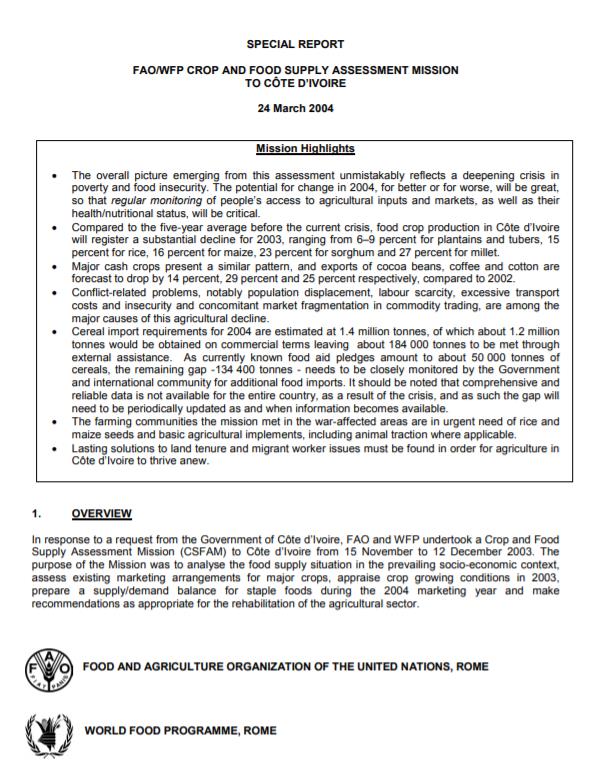
Special Report - FAO/WFP Crop and Food Supply Assessment Mission to n Côte d’Ivoire
24/03/2004
In response to a request from the Government of Côte d’Ivoire, FAO and WFP undertook a Crop and Food Supply Assessment Mission (CSFAM) to Côte d’Ivoire from 15 November to 12 December 2003. The purpose of the Mission was to analyse the food supply situation in the prevailing socio-economic context, assess existing marketing arrangements for major crops, appraise crop growing conditions in 2003, prepare a supply/demand balance for staple foods during the 2004 marketing year and make recommendations as appropriate for the rehabilitation of the agricultural sector.
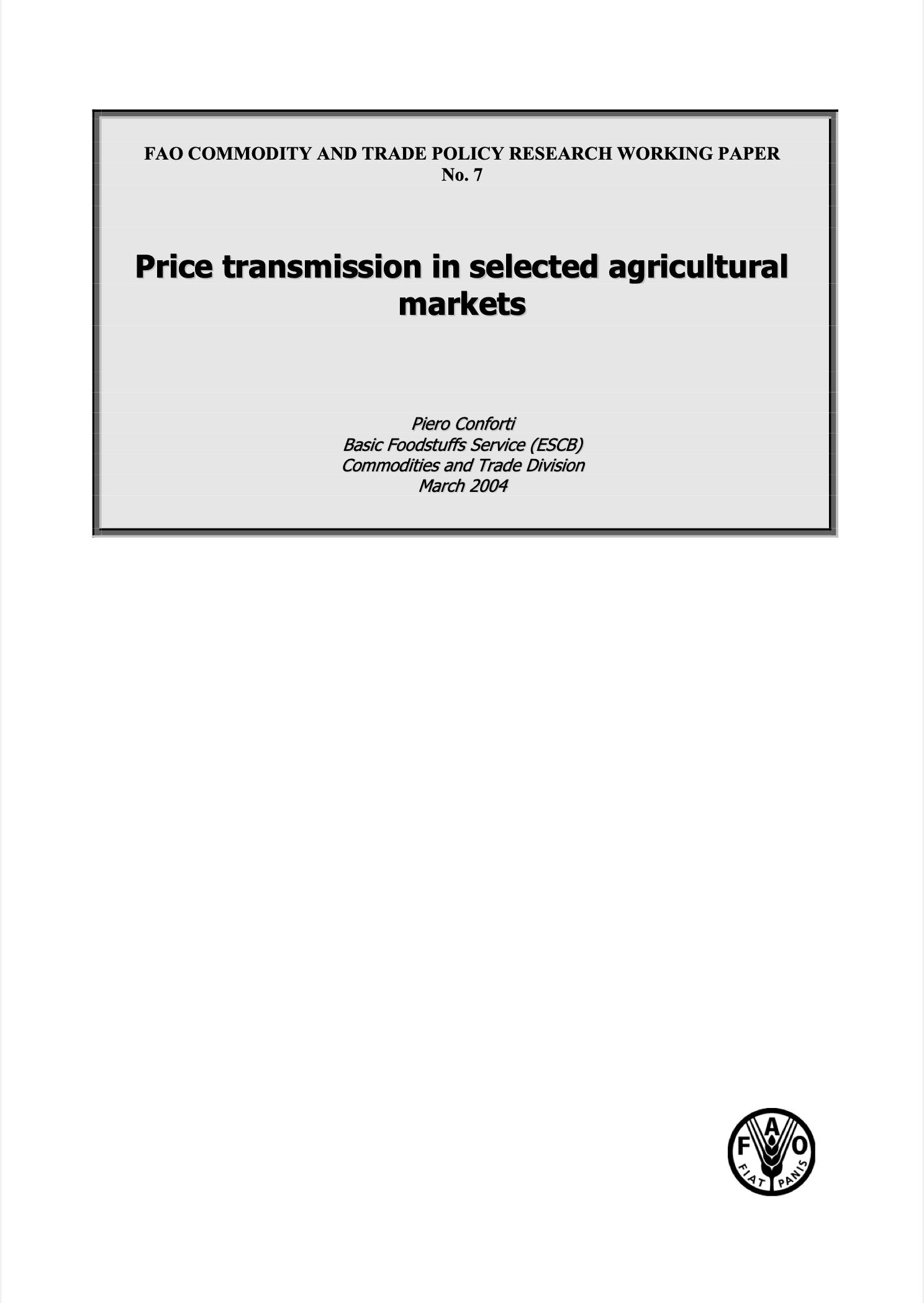
Price transmission in selected agricultural markets
09/03/2004
The paper is aimed at providing evidence on price transmission in a number of agricultural markets, both per se and in support of analytical efforts in the area of agricultural trade policy analysis. Work is based on a price database collected from various sources in sixteen countries - Argentina, Brazil, Chile, Costa Rica, Egypt, Ethiopia, Ghana, India, Indonesia, Mexico, Pakistan, Senegal, Thailand, Turkey, Uganda, and Uruguay - primarily for basic food commodities. Both spatial and vertical price relations are considered, as the database includes prices at the producer, wholesale and retail levels. These are supplemented with information from FAOSTAT. Data are analyzed with an econometric framework based on the estimation of Autoregressive Distributed Lag models, and of the corresponding Error Correction specification. Tests for Granger causality and for asymmetric transmission are also performed. Results indicate that the African markets included in the sample are characterized by more incomplete transmission compared to Latin American and Asian markets.
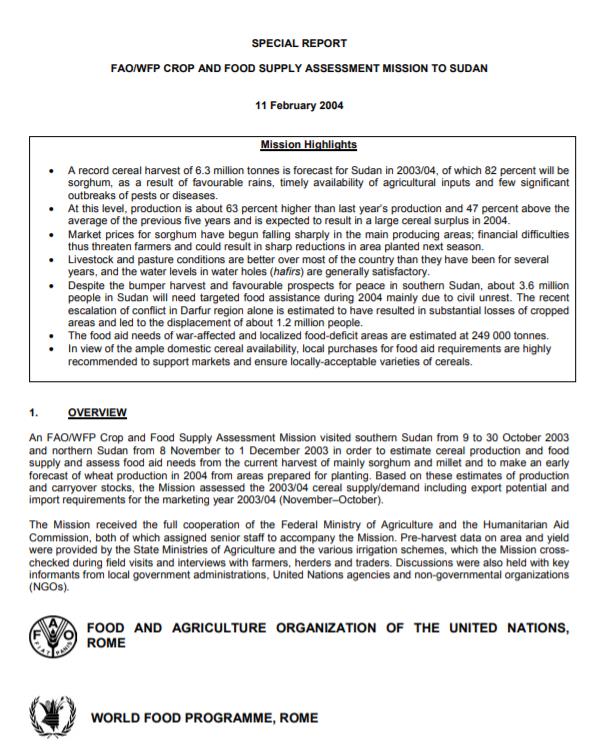
Special Report - FAO/WFP Crop and Food Supply Assessment Mission to Sudan - 11 February 2004
11/02/2004
An FAO/WFP Crop and Food Supply Assessment Mission visited southern Sudan from 9 to 30 October 2003 and northern Sudan from 8 November to 1 December 2003 in order to estimate cereal production and food supply and assess food aid needs from the current harvest of mainly sorghum and millet and to make an early forecast of wheat production in 2004 from areas prepared for planting. Based on these estimates of production and carryover stocks, the Mission assessed the 2003/04 cereal supply/demand including export potential and import requirements for the marketing year 2003/04 (November–October).
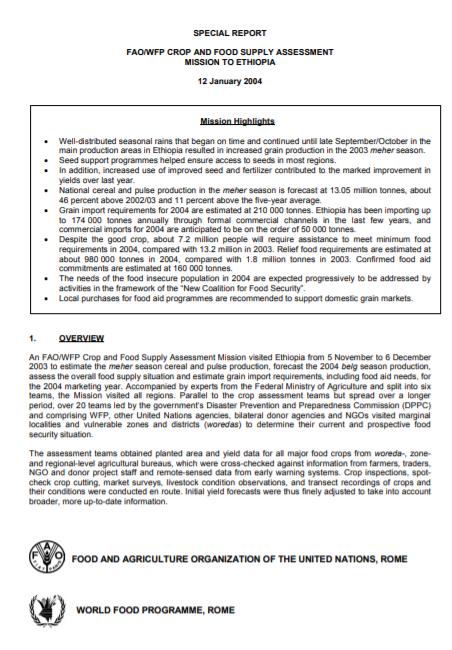
Special Report - FAO/WFP Crop and Food Supply Assessment Mission to Ethiopia - 12 January 2004
12/01/2004
An FAO/WFP Crop and Food Supply Assessment Mission visited Ethiopia from 5 November to 6 December 2003 to estimate the meher season cereal and pulse production, forecast the 2004 belg season production, assess the overall food supply situation and estimate grain import requirements, including food aid needs, for the 2004 marketing year. Accompanied by experts from the Federal Ministry of Agriculture and split into six teams, the Mission visited all regions. Parallel to the crop assessment teams but spread over a longer period, over 20 teams led by the government’s Disaster Prevention and Preparedness Commission (DPPC) and comprising WFP, other United Nations agencies, bilateral donor agencies and NGOs visited marginal localities and vulnerable zones and districts (woredas) to determine their current and prospective food security situation.
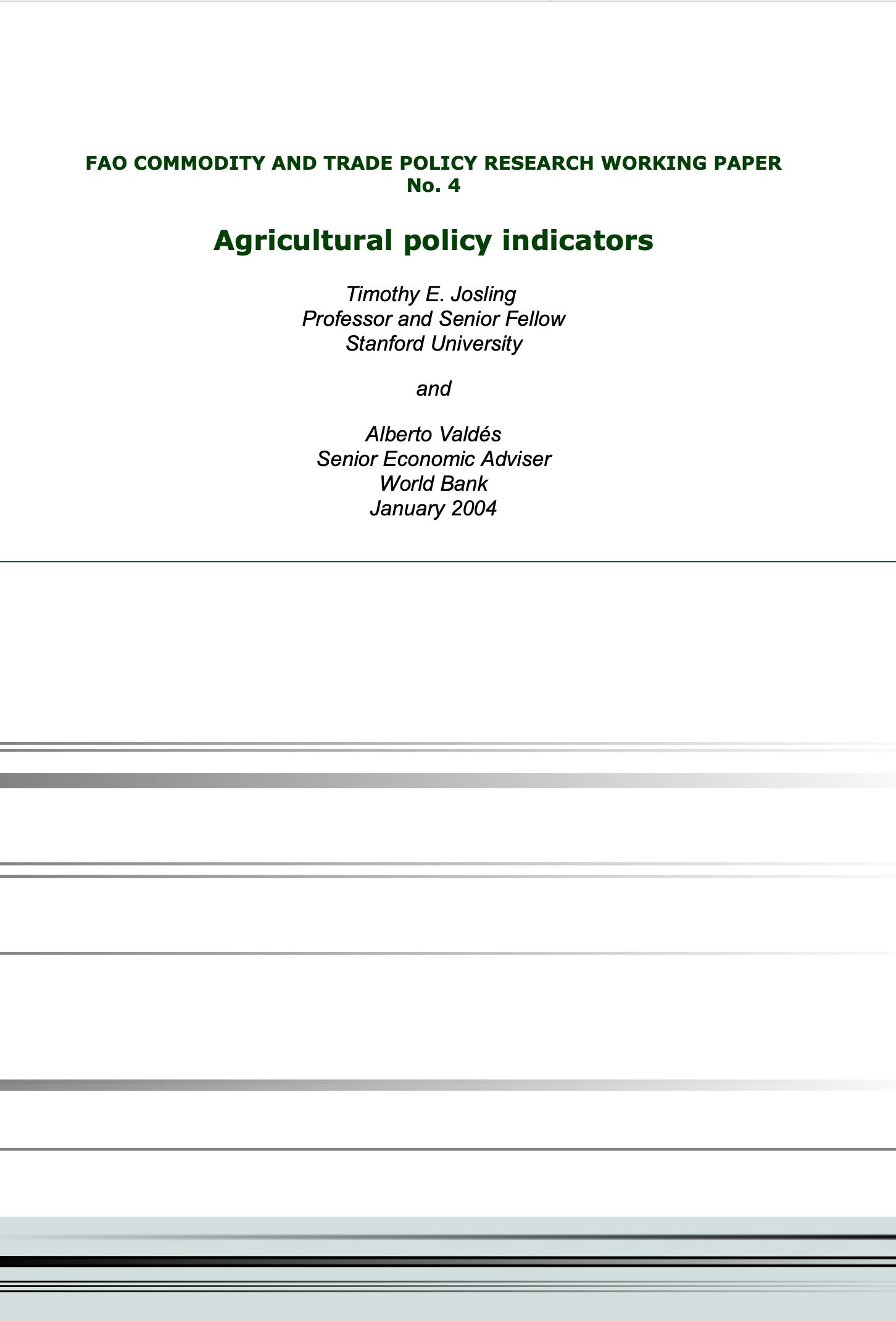
Agricultural policy indicators
01/01/2004
This paper outlines a methodological approach for use by FAO to collect, analyze and monitor agricultural policy indicators (API) for developing countries. The aim is to establish a consistent and comparable set of policy indicators, allowing analysts to examine whether agriculture in particular countries is being stimulated or retarded by the set of policies employed. The API should also be useful in the context of quantitative models of policy impacts and market projections. Ideally, the indicators should function as building blocks for the more comprehensive policy measurement. This paper is presented in four parts. Part 1 gives an overview of the rationale for monitoring, the relationship between policy monitoring, quantitative modelling and evaluation, and the basic menu of choices of indicators. Part 2 provides a brief review of the studies that have calculated the extent of agricultural support in developed countries since 1973 and of the comparable exercises that have focused on developing countries, mainly published since 1990. In light of the apparent "success" or "failure" of the studies mentioned above, and of the authors' experience with many of them, Part 3 identifies several areas that in our opinion deserve special attention in the planning of the FAO-sponsored studies. We attempt to provide insights into methodological, computational and logistical problems that might be faced by FAO. Part 4 suggests a methodological approach for FAO, elaborating on the suggested coverage, definitions, classification criteria and methods of calculation.
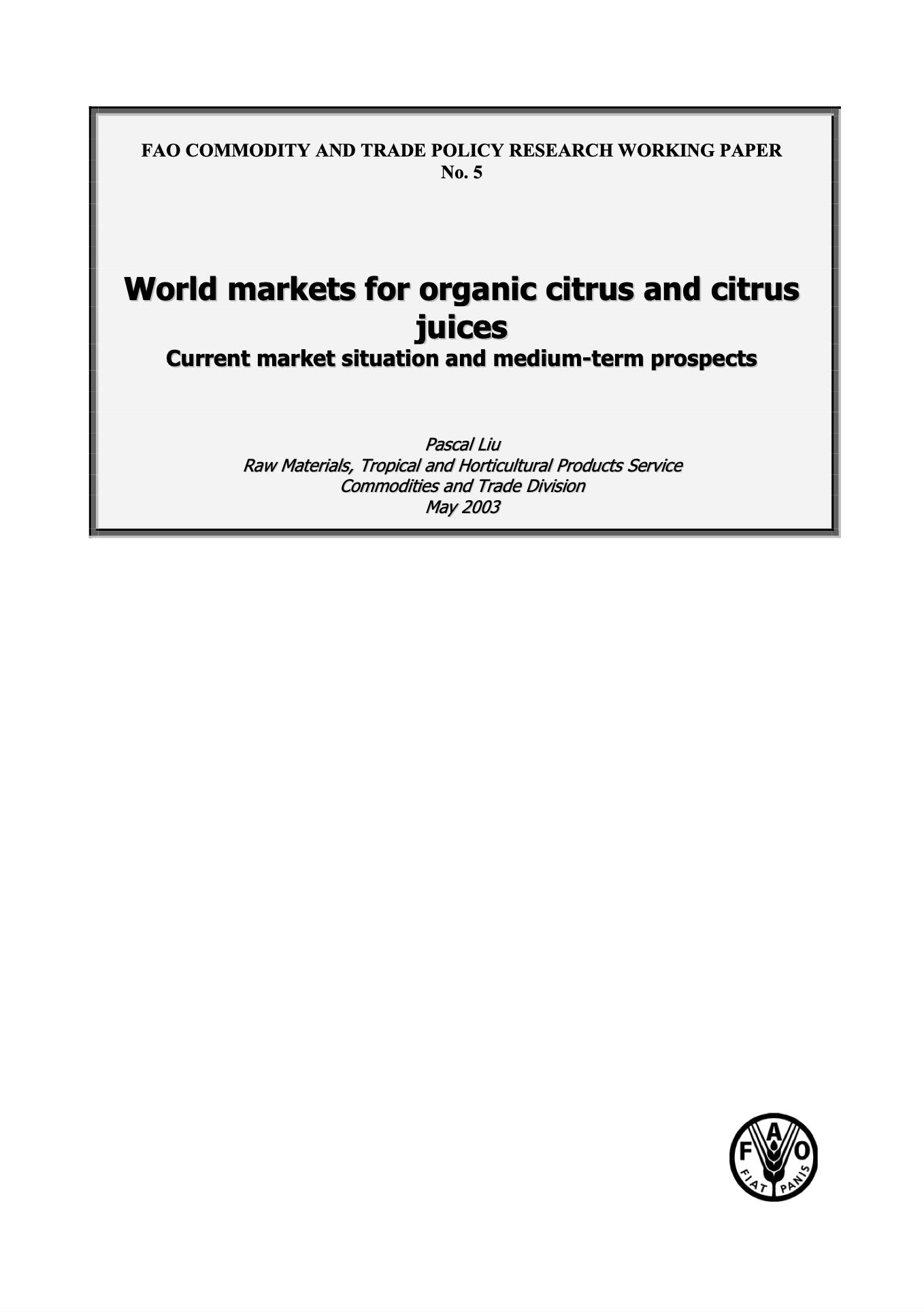
World markets for organic citrus and citrus juices
01/01/2004
The world market for certified organic citrus (fresh and juice) is presently small and production accounts for less than 1 percent of global citrus production. The main markets are the European Community and the United States, which are also the world’s largest two producers. Consumption of organic citrus is expected to rise steadily in developed countries in the coming years, providing interesting export opportunities.
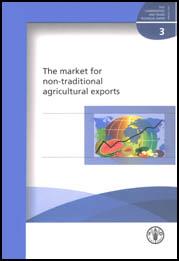
The market for non-traditional agricultural exports
01/01/2004
The last decade has witnessed a steady decline in the dollar values of many of the traditional agricultural export crops (TAEs) from developing countries and has highlighted the risks of depending upon a very narrow export base for foreign exchange earnings. Breaking the dependence upon the traditional primary commodities and diversifying into higher value or added value exports is not easy. This report provides an overview of the market for non-traditional agricultural exports (NTAEs). In parti cular, the report focuses upon the trends in international trade in these products, the trade and import policies of the major destination buyers, the extent of the “adding-up” problem for selected NTAEs, the lessons learned, and the prospects for developing niche markets for organic and fair trade NTAEs. The report provides detailed statistical data on trends in the export of NTAEs during the ten-year period 1992 to 2001, both in volume and value terms, analyses the contribution of develop ing countries and least-developed countries (LDCs) to trade in NTAEs and identifies the leading developing country exporters. Trade and import policies of the key destination countries for NTAEs: the European Union, the United States and Japan are examined. Trade barriers such as tariffs and other import measures, including the complex area of phytosanitary controls, are examined and the impact of tariff liberalization, tariff escalation and the extent of tariff preferences for developing countr y exporters of NTAEs are discussed.
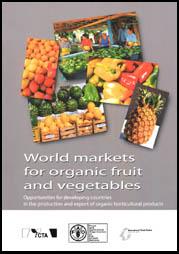
World markets for organic citrus and citrus juices -Current market situation and medium-term prospects
01/01/2004
The world market for certified organic citrus (fresh and juice) is presently small and production accounts for less than 1 percent of global citrus production. The main markets are the European Community and the United States, which are also the world’s largest two producers. Consumption of organic citrus is expected to rise steadily in developed countries in the coming years, providing interesting export opportunities.
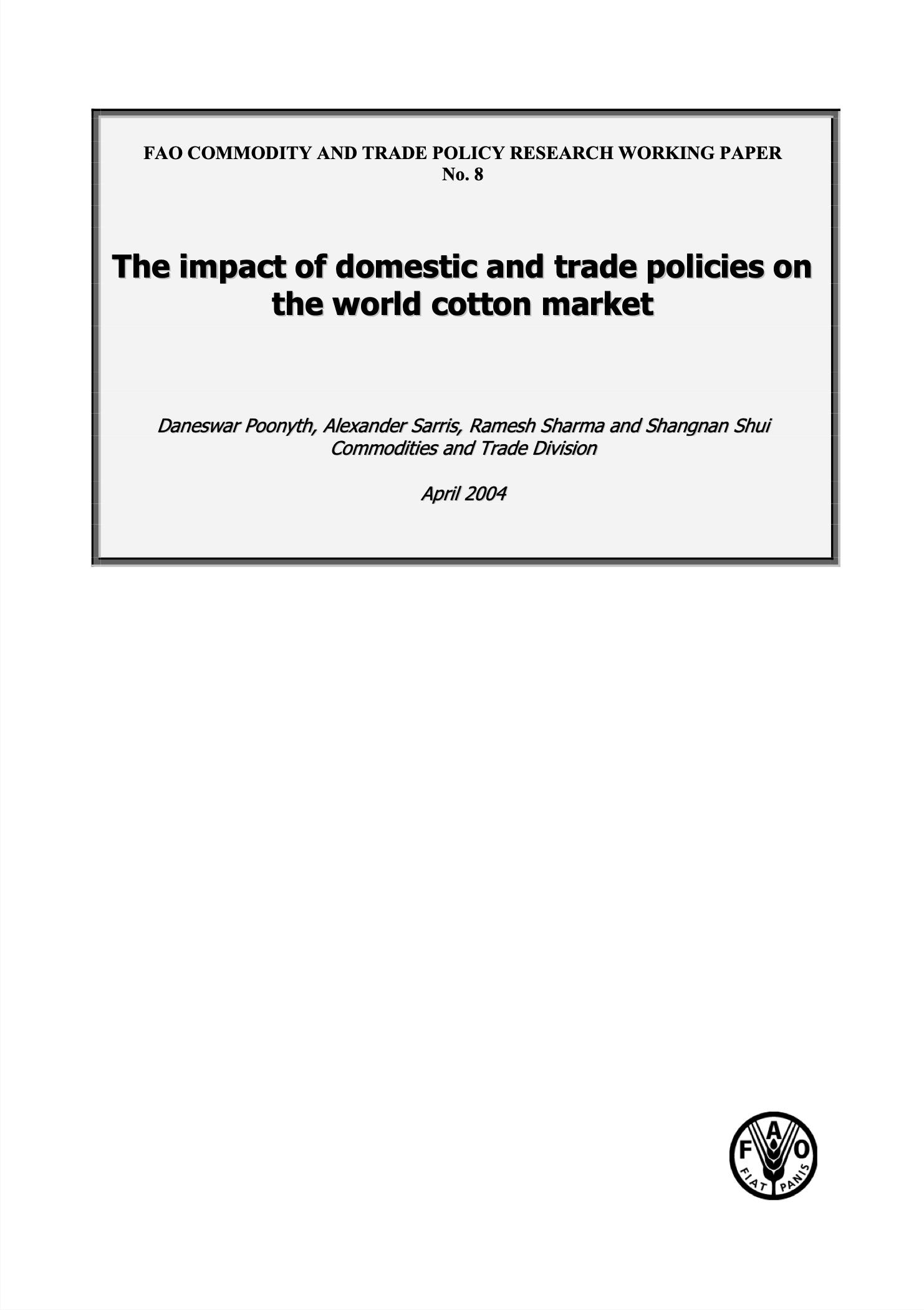
The impact of domestic and trade policies on the world cotton market
01/01/2004
There is a long tradition in the quantification of the impact of agricultural trade distortions on global markets, trade, and individual countries, notably in the context of the ongoing multilateral trade negotiations. This paper analyses the case of cotton in this context. Recently, the issue of cotton subsidies and their likely negative effects has attracted considerable attention and controversy. There are some model-based assessments of the impact, and their results differ markedly. While th e models utilized are similar in structure, the differences are in the assumptions about the levels of subsidies, as well as market parameters. This study presents some fresh estimates of the likely impact of cotton subsidies on both subsidizing and non-subsidizing countries using the UNCTAD-FAO ATPSM model. The analysis is based on official subsidies as notified to the WTO.

Agricultural trade liberalization in the Doha round. Alternative scenarios and strategic interactions between developed and developing countries
01/01/2004
The paper explores the impact of an agricultural trade agreement, simulating alternative liberalization scenarios, and studying the outcomes of the interaction between the strategies of country groups in the negotiations. The analysis is based on the model of the Global Trade Analysis Project (GTAP), and on the related version 5.4 database. Scenarios are run on a 2013 baseline, built by taking into account a number of events that have affected (and will further affect) world agricultural markets up to that period, focusing on the effects that are specifically attributable to further trade liberalization in the Doha Round. The policy strategies analyzed are two liberalization scenarios based on the proposals made in the present round of agricultural negotiations in terms of market access and export competition, plus a free agricultural trade benchmark scenario. Simulations are employed to study the interactions between the possible strategies of two wide country groups – developed and d eveloping countries on the basis of game theory, and to search for mutually advantageous agreements to be compared with actual agreement hypotheses. Results indicate that welfare gains could be reaped both by developed and developing countries and the possibility of inter-country compensations would allow, at least in principle, an agreement to be reached.
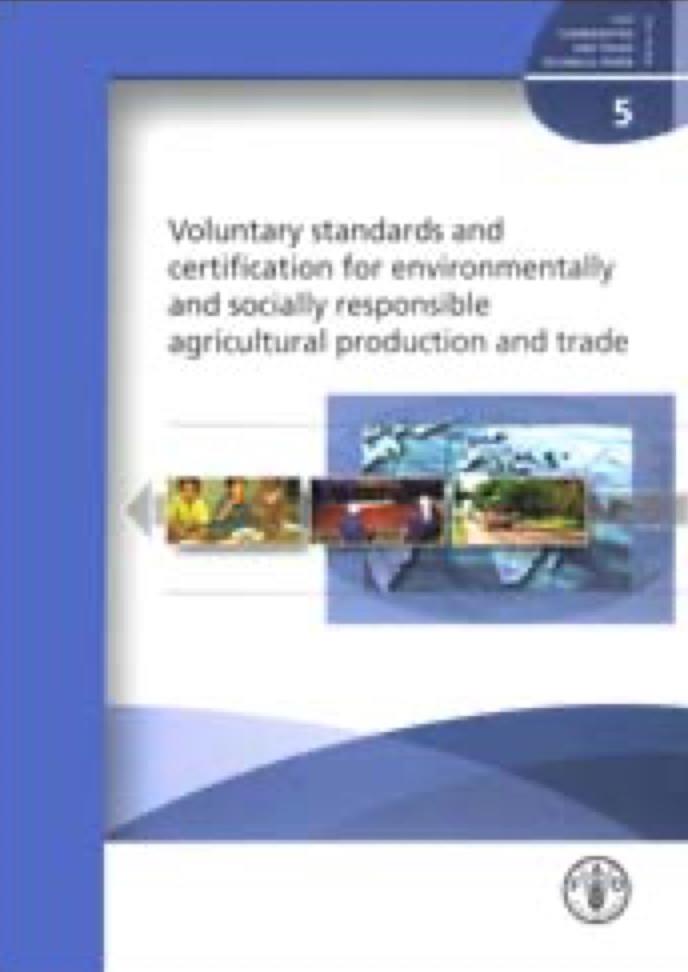
Voluntary Standards and Certification for Environmentally and Socially Responsible Agricultural Production and Trade
01/01/2004
This report summarizes the presentations and discussions that took place during the "FAO Meeting on Voluntary Standards and Certification for Environmentally and Socially Responsible Agricultural Production and Trade" (Rome, 22 April 2004). Over 120 participants from all over the world gathered to discuss issues related to the promotion of environmentally and socially sustainable agricultural practices. The meeting was held in close collaboration and back-to-back with the final conference of the SASA project held at FAO on 21 April 2004. It marked the first time that FAO engaged such a wide variety and number of non-governmental organizations (NGOs), private sector stakeholders and other institutions to further the development of responsible agricultural production and trade. Moreover, it demonstrated the commitment of the Organization to discuss the issue of voluntary standards and certification initiatives in relation to how they may benefit small farmers, plantation workers, rural communities and society as a whole.
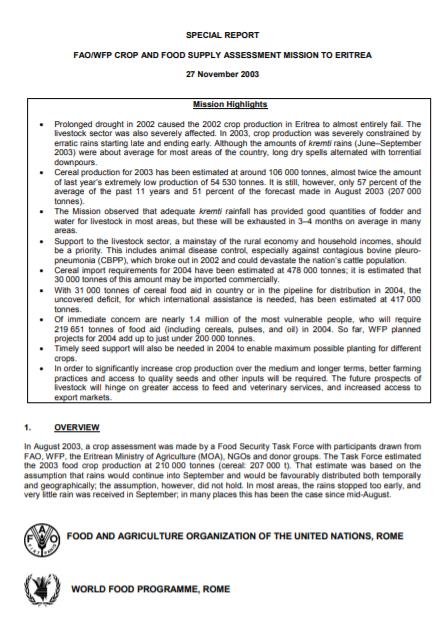
Special Report - FAO/WFP Crop and Food Supply Assessment Mission to Eritrea - 27 November 2003
27/11/2003
An FAO/WFP Crop and Food Assessment Mission visited Eritrea from 25 October to 12 November 2003 to assess the 2003 production of the main cereals and pulses as well as the condition of the livestock, review the overall food situation and estimate the cereal import requirement for 2004 – including food aid needs – and identify essential support activities towards crop production and livestock management in 2004.
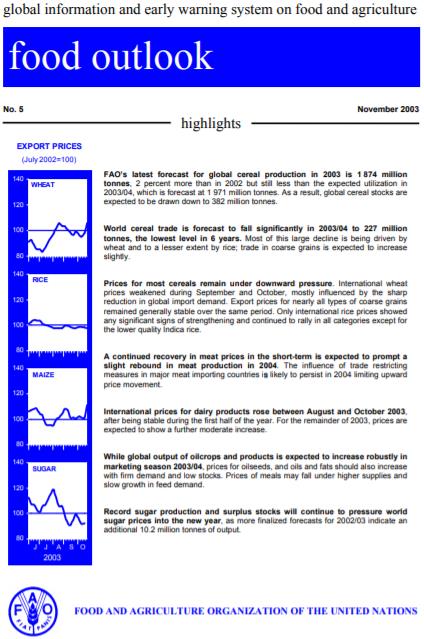
Food Outlook - November 2003
03/11/2003
FAO’s latest forecast for global cereal production in 2003 is 1 874 million tonnes, 2 percent more than in 2002 but still less than the expected utilization in 2003/04, which is forecast at 1 971 million tonnes. As a result, global cereal stocks are expected to be drawn down to 382 million tonnes. World cereal trade is forecast to fall significantly in 2003/04 to 227 million tonnes, the lowest level in 6 years. Most of this large decline is being driven by wheat and to a lesser extent by rice; trade in coarse grains is expected to increase slightly. Prices for most cereals remain under downward pressure. International wheat prices weakened during September and October, mostly influenced by the sharp reduction in global import demand. Export prices for nearly all types of coarse grains remained generally stable over the same period. Only international rice prices showed any significant signs of strengthening and continued to rally in all categories except for the lower quality Indica rice. A continued recovery in meat prices in the short-term is expected to prompt a slight rebound in meat production in 2004. The influence of trade restricting measures in major meat importing countries is likely to persist in 2004 limiting upward price movement. International prices for dairy products rose between August and October 2003, after being stable during the first half of the year. For the remainder of 2003, prices are expected to show a further moderate increase. While global output of oilcrops and products is expected to increase robustly in marketing season 2003/04, prices for oilseeds, and oils and fats should also increase with firm demand and low stocks. Prices of meals may fall under higher supplies and slow growth in feed demand. Record sugar production and surplus stocks will continue to pressure world sugar prices into the new year, as more finalized forecasts for 2002/03 indicate an additional 10.2 million tonnes of output.
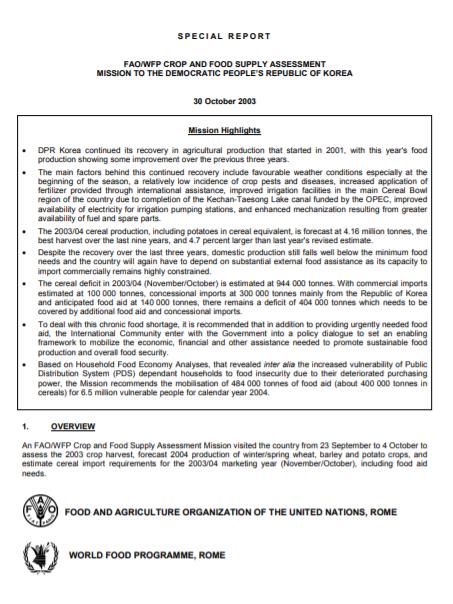
Special Report - FAO/WFP Crop and Food Supply Assessment Mission to the Democratic People's Republic of Korea - 30 October 2003
30/10/2003
An FAO/WFP Crop and Food Supply Assessment Mission visited the country from 23 September to 4 October to assess the 2003 crop harvest, forecast 2004 production of winter/spring wheat, barley and potato crops, and estimate cereal import requirements for the 2003/04 marketing year (November/October), including food aid needs.


